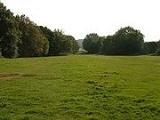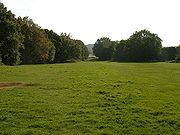
Galleywood
Encyclopedia
Galleywood is a village surrounded by countryside in Essex
, about 30 miles from London
, and close to the town of Chelmsford
. It is off the A12 which connects to the M25
in London
. Galleywood has a population of 5,757http://www.chelmsford.gov.uk/index.cfm?articleid=11766, and has a higher percentage of retired citizens than the national average.
Galleywood Common is approximately 400 yards in width and one mile in length, and consists of open fields and woodland. It also has St. Michaels Church in the woodland, which is visible for miles around.
In early-Victorian times the village was centred on The Eagle crossroads, The Street and Well Lane, education being provided by a school that doubled as a Chapel of Ease on Sundays and by a Methodist chapel built in Well Lane.
Council housing was developed in the 1930s, with major building programmes during the early 1960s and through the 1970s. Private development was carried out concurrently and continued over the following three decades. The population has grown from under 800 in 1851 to around 1,000 in 1951 and to over 6,000 in 2004.
From all approaches Galleywood is separated either by open farmland, wooded slopes or green areas, free from ribbon development, giving a true rural feel to visitors and residents alike. Within the village outskirts there are several surviving long established working farms, some with buildings dating back to the 14th century.
The civil parish of Galleywood covers an area of 2200 acres and was established in 1987, with the transference of responsibility from Great Baddow to the newly created Galleywood Parish Council.
Defensive fortifications during the Napoleonic Wars (1803 - 1813)
A large star-shaped Fort with artillery batteries, redoubts and earthwork fortifications were built on the racecourse astride the Margaretting Road in response to an invasion threat by French forces on the Essex coast. These defence works were decommissioned around 1813.
Galleywood Racecourse (1759 - 1935)
The historic Galleywood Racecourse on Galleywood Common in the Borough of Chelmsford, Essex was the scene of the Chelmsford Races for 176 years.
Chelmsford Golf Course (1893 - 1912)
In 1893 when the 9-hole golf course, designed by Tom Dunn, opened on Galleywood Common the game bore little relation to what it is today. It was played with a gutta-percha ball and clubs with hickory shafts hence the seemingly generous “Par”
score allocations for each hole.
Cyril Yorker who caddied in 1910 described the course as no Gleneagles or Wentworth, just a great expanse of gorse and heather where more time was spent hunting for the balls than actually playing.
Chelmsford Golf Club was constituted in 1893 and played on Galleywood Common until they moved to Widford in 1912.
Brickworks
Brick making in the 19th and early-20th centuries
Army Training Ground and Artillery Defences (1914 - 1918)
The Grandstand and the Common were taken over by the Army for the duration of the First World War.
 Galleywood's race course was first formally mentioned in 1770. In that year that the track's main event was granted the title of the "Queen's Plate" by King George III.
Galleywood's race course was first formally mentioned in 1770. In that year that the track's main event was granted the title of the "Queen's Plate" by King George III.
The race course began to fall into decline from the late 19th and 20th centuries. It was bought for housing land after World War II
, although parts of the course remain around the common. It was the only race course in the country to go around a church.
, football
, netball
, tennis
, cricket
, and rounders
. It is the home of Chelmsford Hockey Club
, the Chelmsford Cricket Club, and the Galleywood Football Club. It has a playground area for young children.
Galleywood has Jubilee Recreational Park with a playground area and is the meeting point of Galleywood Scouts.
Essex
Essex is a ceremonial and non-metropolitan county in the East region of England, and one of the home counties. It is located to the northeast of Greater London. It borders with Cambridgeshire and Suffolk to the north, Hertfordshire to the west, Kent to the South and London to the south west...
, about 30 miles from London
London
London is the capital city of :England and the :United Kingdom, the largest metropolitan area in the United Kingdom, and the largest urban zone in the European Union by most measures. Located on the River Thames, London has been a major settlement for two millennia, its history going back to its...
, and close to the town of Chelmsford
Chelmsford
Chelmsford is the county town of Essex, England and the principal settlement of the borough of Chelmsford. It is located in the London commuter belt, approximately northeast of Charing Cross, London, and approximately the same distance from the once provincial Roman capital at Colchester...
. It is off the A12 which connects to the M25
M25 motorway
The M25 motorway, or London Orbital, is a orbital motorway that almost encircles Greater London, England, in the United Kingdom. The motorway was first mooted early in the 20th century. A few sections, based on the now abandoned London Ringways plan, were constructed in the early 1970s and it ...
in London
London
London is the capital city of :England and the :United Kingdom, the largest metropolitan area in the United Kingdom, and the largest urban zone in the European Union by most measures. Located on the River Thames, London has been a major settlement for two millennia, its history going back to its...
. Galleywood has a population of 5,757http://www.chelmsford.gov.uk/index.cfm?articleid=11766, and has a higher percentage of retired citizens than the national average.
Galleywood Common is approximately 400 yards in width and one mile in length, and consists of open fields and woodland. It also has St. Michaels Church in the woodland, which is visible for miles around.
History
Galleywood dates back to early medieval times and was recorded in 1250 as Gauelwode (Galleywood Common), a hamlet of Great Baddow, part of an ancient forest interspersed with open scrubland.In early-Victorian times the village was centred on The Eagle crossroads, The Street and Well Lane, education being provided by a school that doubled as a Chapel of Ease on Sundays and by a Methodist chapel built in Well Lane.
Council housing was developed in the 1930s, with major building programmes during the early 1960s and through the 1970s. Private development was carried out concurrently and continued over the following three decades. The population has grown from under 800 in 1851 to around 1,000 in 1951 and to over 6,000 in 2004.
From all approaches Galleywood is separated either by open farmland, wooded slopes or green areas, free from ribbon development, giving a true rural feel to visitors and residents alike. Within the village outskirts there are several surviving long established working farms, some with buildings dating back to the 14th century.
The civil parish of Galleywood covers an area of 2200 acres and was established in 1987, with the transference of responsibility from Great Baddow to the newly created Galleywood Parish Council.
Galleywood Common
Galleywood Common comprises 175 acres and was declared a Local Nature Reserve in 1993. It is an ancient man-made landscape, first recorded in Domesday (1086). The Common has a very strong character and has always been an important feature of the hamlet around which the village grew, providing grazing land, furze and wood for gathering and gravel for building and road making. The Common has had many uses throughout the ages:Defensive fortifications during the Napoleonic Wars (1803 - 1813)
A large star-shaped Fort with artillery batteries, redoubts and earthwork fortifications were built on the racecourse astride the Margaretting Road in response to an invasion threat by French forces on the Essex coast. These defence works were decommissioned around 1813.
Galleywood Racecourse (1759 - 1935)
The historic Galleywood Racecourse on Galleywood Common in the Borough of Chelmsford, Essex was the scene of the Chelmsford Races for 176 years.
Chelmsford Golf Course (1893 - 1912)
In 1893 when the 9-hole golf course, designed by Tom Dunn, opened on Galleywood Common the game bore little relation to what it is today. It was played with a gutta-percha ball and clubs with hickory shafts hence the seemingly generous “Par”
score allocations for each hole.
Cyril Yorker who caddied in 1910 described the course as no Gleneagles or Wentworth, just a great expanse of gorse and heather where more time was spent hunting for the balls than actually playing.
Chelmsford Golf Club was constituted in 1893 and played on Galleywood Common until they moved to Widford in 1912.
Brickworks
Brick making in the 19th and early-20th centuries
Army Training Ground and Artillery Defences (1914 - 1918)
The Grandstand and the Common were taken over by the Army for the duration of the First World War.
Race course

The race course began to fall into decline from the late 19th and 20th centuries. It was bought for housing land after World War II
World War II
World War II, or the Second World War , was a global conflict lasting from 1939 to 1945, involving most of the world's nations—including all of the great powers—eventually forming two opposing military alliances: the Allies and the Axis...
, although parts of the course remain around the common. It was the only race course in the country to go around a church.
Schools
There are 3 schools in Galleywood, Galleywood Infants School, St. Michael's C of E Junior School and The Thriftwood SchoolParks
Galleywood is home to the Chelmer Park which has facilities for hockeyHockey
Hockey is a family of sports in which two teams play against each other by trying to maneuver a ball or a puck into the opponent's goal using a hockey stick.-Etymology:...
, football
Football (soccer)
Association football, more commonly known as football or soccer, is a sport played between two teams of eleven players with a spherical ball...
, netball
Netball
Netball is a ball sport played between two teams of seven players. Its development, derived from early versions of basketball, began in England in the 1890s. By 1960 international playing rules had been standardised for the game, and the International Federation of Netball and Women's Basketball ...
, tennis
Tennis
Tennis is a sport usually played between two players or between two teams of two players each . Each player uses a racket that is strung to strike a hollow rubber ball covered with felt over a net into the opponent's court. Tennis is an Olympic sport and is played at all levels of society at all...
, cricket
Cricket
Cricket is a bat-and-ball game played between two teams of 11 players on an oval-shaped field, at the centre of which is a rectangular 22-yard long pitch. One team bats, trying to score as many runs as possible while the other team bowls and fields, trying to dismiss the batsmen and thus limit the...
, and rounders
Rounders
Rounders is a game played between two teams of either gender. The game originated in England where it was played in Tudor times. Rounders is a striking and fielding team game that involves hitting a small, hard, leather-cased ball with a round wooden, plastic or metal bat. The players score by...
. It is the home of Chelmsford Hockey Club
Chelmsford Hockey Club
Chelmsford Hockey Club is a hockey club from Chelmsford, Essex, England who play in the English Hockey League. The club's home is Chelmer Park.-History:...
, the Chelmsford Cricket Club, and the Galleywood Football Club. It has a playground area for young children.
Galleywood has Jubilee Recreational Park with a playground area and is the meeting point of Galleywood Scouts.

